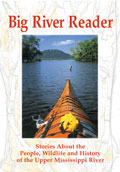|
Big River Reader About two months of sun heats the invisible underground nest to incubate silver-dollar-size progeny who use their unique Òegg toothÓ to open rubbery ping-pong shells.
Predators keep a keen eye for a turtle treat. Overhead, herons and crows scan the shoreline. On land, raccoons, skunks, foxes and coyotes will gobble up a whole batch, if they didnÕt dig up the nest earlier. Underwater, big fish or a bigger turtle may gulp a neophyte.
|
Snapper!By Roger Lacher Wading barefoot in muddy backwaters or knee deep in a trout stream, you stub your toe on something that moves! Your reaction is as predictable and primitive as the creature you picture -- Jurassic jaws clenched on your calf, its small eyes intent in a huge head, neck stretched and wrenching the bone out of your leg, shell like a filthy fossil, cold-blooded claws imbedding the bottom to drag you down. Our image of the snapping turtle is right down there with snakes. Indeed, "chelydra serpentina" translates to "turtle snake," no doubt based on the long flexible neck capable of lightning strikes at food or fools. A more typical encounter occurs from the comfort of a car on highways along the Mississippi. The critter's crossing the road, of course, to get to the other side. Egg-laying sites are select habitats that often parallel our rail and auto corridors. Some turtles get flattened, and some get picked up for supper or sale as fish-market delicacies -- $3.99 a pound at a popular rivertown outlet. This summer mortality of mature females is a factor in Minnesota designating snappers a species of "special concern." John Moriarty of the Minnesota Herpetological Society, suggests that concerned motorists assist road-shoulder snappers by carefully carrying them across, toward their destination, coming or going -- careful not to get bit and gentle not to scare the pee out of them. Lugging a turtle by the tail often causes voiding of the bladder. Since liquid is needed to lay eggs, a shocked snapper may need to go back to the river for a refill in order to complete the annual process -- more stress. Moriarty, co-author of Amphibians and Reptiles Native to Minnesota (University of Minnesota Press), also cites climatological effects on reproduction. The high water and cool temperatures of 1993 resulted in a hatch "close to total failure on the upper Mississippi." This year, this month, let's hope the monster-moms have better luck. The female can be identified by a plastron (belly shell) bulging out instead of indented like a male. At about seven years of age, with a ten-inch shell, she excavates a hole in the appropriate habitat and lays a dozen or more eggs. About two months of sun heats the invisible underground nest to incubate silver-dollar-size progeny who use their unique "egg tooth" to open rubbery ping-pong shells. Recent research suggests that temperature levels during the middle of this period affects the sex of the hatchlings: hotter for females and vice versa. Perhaps it relates to future food supplies. Regardless, the tiny girls and boys dig their way out then run for the water, to disappear. Predators keep a keen eye for a turtle treat. Overhead, herons and crows scan the shoreline. On land, raccoons, skunks, foxes and coyotes will gobble up a whole batch, if they didn't dig up the nest earlier. Underwater, big fish or a bigger turtle may gulp a neophyte. The few that survive the early years get pretty hard to kill by anything but people and their technology. Snapping turtles have evolved to take full advantage of most aquatic environments. They can stay out of water for days, under water long enough to test the temper of the best waiter or way up in spring creeks where other turtles fear to tread. Their diet is catholic: a third vegetation, some fish, a fifth carrion, a few insects and other invertebrates, and occasional vertebrates, such as ducklings. In a restricted habitat, like a pond or narrow trout stream, a big snapper can pull down a brood of mallards or wood ducks, one at a time over a week. In Edmund Wilson's classic 1942 story "The Man Who Shot Snapping Turtles," duck-lover Asa Stryker spends hours on his porch over the pond, obsessively aiming his rifle an inch below the telltale triangle of nostril wake to kill the surfacing enemies. Asa didn't eat them, wished them to simply sink lifeless to the bottom. "Lifeless" is a questionable term to anyone who's ever butchered a snapper for its delectable flesh, seven sorts of meat in one carcass: chicken, beef, shrimp, etc. With the momentum of millennia, they don't know they're dead. Beheaded bodies crawl fish-market concrete to hit the wall like bumper cars, turn to continue for hours on pure reflex. Across the river, a shore-lunch of fresh stew is served. The fisherman notices the heart beating in the gut pile, slows to once a minute, then, to pumping only when prodded with twig at sundown. Yum! The latest of the Minnesota Department of Health's Fish Consumption Advisory recommends eating snapper caught in the Mississippi from the Cities to the Iowa border no more than once a week, due to PCB levels in the critters. At fall's first freeze-up, when bubbles in clear ice over certain backwaters are a sign of hibernating turtles, a homemade hook on a probing pole pulls whole congregations, sometimes a boatload, of sluggish snappers up out of the mud. Stories of 20,000 pounds taken by a single riverman in the early 1960s are possibly true. Unfortunately, these special environments tend to be traditional, so over the years a hibernaculum can be "fished out." Others may "noodle" for snappers. This has nothing to do with pasta, you wade waist deep and reach under the river bank to grab the turtle and haul it out at arm's length. Old-timers claim it's fun, effective and safer than you think. One says he caught over 150 with only three bites. Snappers are more mellow in the water, but watch out for muskrats! "They slash, bite, and chew. YouÕll surely need stitches." Bobby Drazkowski of East Burns Valley, near Winona, Minnesota, is a third-generation outdoorsman with a wealth of hands-on experience along the Mississippi -- like hands on the tail of a turtle too big for the hole in the ice, so a buddy chops gingerly around the freezing wrist to allow exit and harvest. Or, more recently, hand-building nest guards to protect eggs from digging predators. He may personify a generation of river folk adopting a new attitude and ethic regarding natural resources. The Gopher State is ahead of Wisconsin and Iowa in protecting snappers. A minimum size limit of 10 inches across the shell is intended to control harvest to "adults only," but Minnesota's Endangered Flora and Fauna recommends increasing this dimension by two inches and restricting the season to July 1 to October 15, in order to help protect this vulnerable species. Many commercial fishers agree that the population is down in certain spots. Some view snappers like ginseng or rattlesnakes, as part of an ecosystem overharvested in the recent past and maybe more valuable live than dead. Scary, gross, repulsive, hard to get much uglier, reflects our reactions to a creature so bumpy and beak-faced, especially a big one with moss and snails on its back and bloodsuckers in its armpits. A big one is 30 pounds but much larger versions are reported, especially if the scales are weighted in favor of a good story. "Minn," in Hollings C. Holling's famous Minn of the Mississippi (Houghton Mifflin), finished the book at 46. Wisconsin Department of Natural Resource's Scott Craven reports a 55-pound specimen found dead in a Madison lake. Jim Drazkowski got one weighing 68 near Winona. Outdoor writer Byron Dalrymple cites an 86 pounder. And "Minnesota Fats" awed State Fair viewers at a hulking 65 pounds, four feet from nose tip to tail tip. Longevity doesnÕt hurt -- 40 years, 60, rumors of 100! The behemoth you spot crossing the road or sunning on a riverside log is apt to weigh about 10 pounds. It's not going to snap you without provocation or try to crawl up your pant leg. This turtle is here to teach patience and adaptability, to once again inspire a contemporary equivalent to totem mounds that took a lot longer to build than, say, the lock-and-dam system or Great River Road. With a little help, its got time on its side. © June 1994 |



